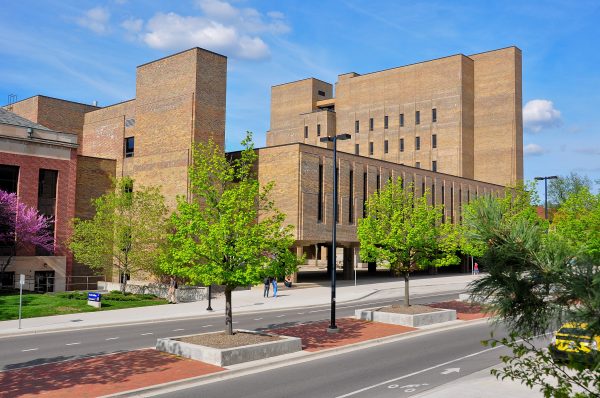
In the past, having a tooth crowned meant visiting the dentist twice: once to bite into thick, pink, not-so-great-tasting putty to create molds of your teeth, followed by having the tooth drilled to make room for a temporary cap; and again, weeks later, to have the newly-made crown put in place.
Luckily for current and future U-M patients and students, the School of Dentistry is using 3D CAD/CAM technology, not only replacing the infamous pink putty, but improving the software involved and accelerating the process from a multi day/week process to as littles as a single, three-hour appointment. Students benefit because learning this technology is now part of the curriculum and will prepare them for using in their own practices.
The School of Dentistry is using the Sirona Cerec intraoral scanner with 3D CAD/CAM technology to make crowns more efficient. During an appointment, the camera at the end of a wand-shaped scanner takes a series of images of the patient’s teeth at different angles. Those images, stored on a Cerec computer cart, are then translated into a 3D model that can be manipulated, refined, and shared more easily than those made with putty.
While the technology has been extremely useful, Cerec software also presented challenges. Previously, each Cerec cart was a standalone solution: faculty and students could only access and work on their 3D models through the specific cart they used during the appointment. This meant that faculty and students had to remember the number on the individual carts they used for each patient, and if someone else was already using the one they needed, it could take hours waiting for their turn.
In 2020, Dental Informatics, system administrators, and faculty champions worked closely together to develop and implement a plan to link all of the Cerec carts to a centralized database. This made it possible to access any 3D model from any cart or design station. Because the Cerec software was not designed with this setup in mind, it was a complicated, but not impossible, task.
Now that this centralized database has been created, faculty and students are able to grab any Cerec cart, capture their 3D model, and work on their models from that cart or any other design station. As expected, this has proven much more efficient and convenient for faculty, students, and patients.
In addition to making crownings and other dentistry appointments easier, the database has also improved the School of Dentistry’s simulation lab (SimLab). The SimLab, where students learn to use the Cerec modeling software, utilizes the new database with all 18 Cerec carts available. The SimLab has incorporated ITS’s AppsAnywhere service to make running and support of the software across its 110 SimLab stations easier.
Integrating Cerec software with AppsAnywhere has made updates to the software much easier too. Previously, installing and updating had to be done manually. With 110 lab stations, even minor updates were time-consuming and tedious. With AppsAnywhere, it is saving staff between 30 and 40 hours of work for each update release, up to twice a year.
AppsAnywhere allows users to run virtualized and cloned software installation images from an easy-to-access portal. It also allows for simplified updates, which makes a significant difference when maintaining more than 100 computers. Still, because Cerec software was designed for private practices rather than anything as large as the School of Dentistry and the SimLab, learning how to connect the computer carts together for collective, rather than individual, software updates was a process.
The Cerec carts were strategically added to the campus domain in order to connect them to a secure PHI compliant wifi network and more effectively manage the carts’ security and updates. Although this network still presents some challenges, such as slow loading times for the data-heavy 3D models, the new setup has plenty of advantages, most notably the flexibility of simpler software maintenance and the ability to deploy to target machines at any time. It also has a great deal of potential to further accommodate faculty and students’ specific needs.
The program and its use of Cerec technology continues to grow. The school currently has 14 carts in pre-clinic and 4 in-clinic, with expectations to acquire more. As another exciting next step, the School of Dentistry expects to expand on existing in-house manufacturing capabilities; rather than having to send models out for fabrication, there will be 3D printers, mills, and design stations where students can create their own molds.
Sirona Cerec 3D CAD/CAM technology has been appreciated by students, faculty, and patients alike since it was first introduced to replace molding putty. Though the limited, individual nature of the original software has presented complications for students and faculty both during appointments and in the simulation lab, those complications have been overcome by teamwork and ingenuity, making crownings, trainings, and other procedures as efficient and effective as possible.
As the technology in dentistry continues to evolve, the School of Dentistry will continue to adapt to the latest technology while simultaneously adapting that technology to the unique needs of students, faculty, and patients.
